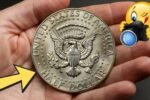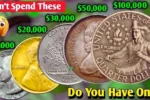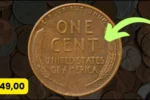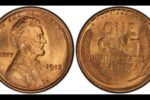A Sacagawea Dollar : In a twist of fate that sounds more like a scene from a movie than real life, a seemingly ordinary Sacagawea dollar—mistaken for a mere arcade token—ended up transforming the life of a casual coin collector in the U.S.
The coin, which had been sitting unnoticed in a tin of miscellaneous change for years, was initially dismissed as nothing special. But what appeared to be just another dollar coin turned out to be a rare minting error—one of the few known Sacagawea dollars struck on a different metal planchet.
A Lucky Find in a Forgotten Box
The story begins in rural Oregon, where 32-year-old Evan Clarke was helping his grandmother clear out her garage. Among the forgotten keepsakes and dusty boxes was an old coffee tin filled with coins from various decades. Evan, a part-time collector and history enthusiast, began sorting through the coins without much expectation.
“I saw this golden coin and thought it looked like one of those old Chuck E. Cheese tokens,” Clarke said. “It didn’t feel like real money.”
But something about the coin made him pause. It carried the familiar image of Sacagawea and her infant son, Jean Baptiste, on the obverse. The reverse showed a soaring eagle—a design typical of Sacagawea dollars minted between 2000 and 2008. Still, the weight and tone of the metal felt different, and the edge appeared slightly off.
From Doubt to Discovery
Out of curiosity, Clarke took the coin to a local coin shop for appraisal. What he learned stunned him.
The coin was a Sacagawea dollar struck on a Susan B. Anthony planchet—an ultra-rare minting mistake. Experts believe only a few of these exist, created during the early transitional period at the U.S. Mint around 2000, when the Sacagawea series replaced the Susan B. Anthony dollar.
The coin’s unusual weight, composition, and appearance made it a high-value collector’s item.
“It’s the kind of mint error that collectors dream of finding. It’s not just rare—it’s extremely rare,” said James Holloway, a professional numismatist based in Portland. “These transitional error coins can fetch anywhere from $50,000 to over $100,000 depending on condition and provenance.”
Life-Changing Auction
Clarke decided to send the coin for authentication and grading. Once certified by a top coin grading agency as a “Mint Error—Wrong Planchet,” the coin went to auction. The final sale price? A staggering $78,500.
For Clarke, the sale meant more than just a big check. He used the funds to pay off student loans, invest in his small online business, and set aside money for future coin collecting adventures.
“This coin literally changed the course of my life,” he said. “It made me realize that history can be hiding in plain sight—even in a jar of old change.”
Hidden Value in Pocket Change
The Sacagawea dollar, introduced in 2000, was designed to encourage coin use in everyday transactions, but it never caught on widely. As a result, many ended up in drawers, jars, or even tossed aside as novelty pieces. That’s exactly why these coins, especially mint errors or early transitional pieces, can sometimes be worth far more than their face value.
Numismatists emphasize that mint errors like Clarke’s are incredibly uncommon but not impossible to find. With the right mix of curiosity and luck, regular people occasionally stumble upon coins that rewrite their financial story.
Final Thoughts
Evan Clarke’s story is a reminder that something as simple as pocket change can hold surprising value—especially for those who take a second look. In an era where digital payments dominate, perhaps it’s time to dig through those old jars, wallets, or boxes in the attic.
FAQs
Q1: What is the Sacagawea dollar?
A: The Sacagawea dollar is a U.S. coin first issued in 2000 featuring Sacagawea, the Native American woman who helped guide the Lewis and Clark expedition. It has a distinctive golden color but is not made of actual gold.
Q2: Why was the coin mistaken for a token?
A: Some early Sacagawea dollars had an unusual appearance or were used in promotional campaigns, leading people to confuse them with arcade or transit tokens.
Q3: How did the mistaken identity change a collector’s life?
A: A collector recognized a rare or error version of the coin that was misidentified as a token, discovering it to be extremely valuable—potentially worth thousands of dollars.




